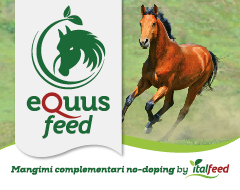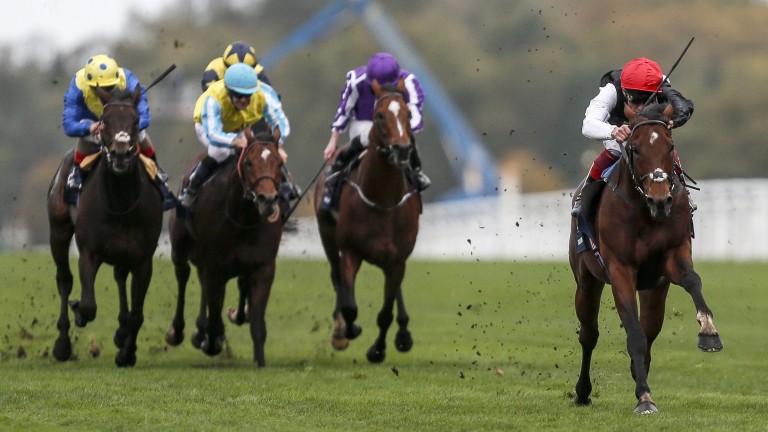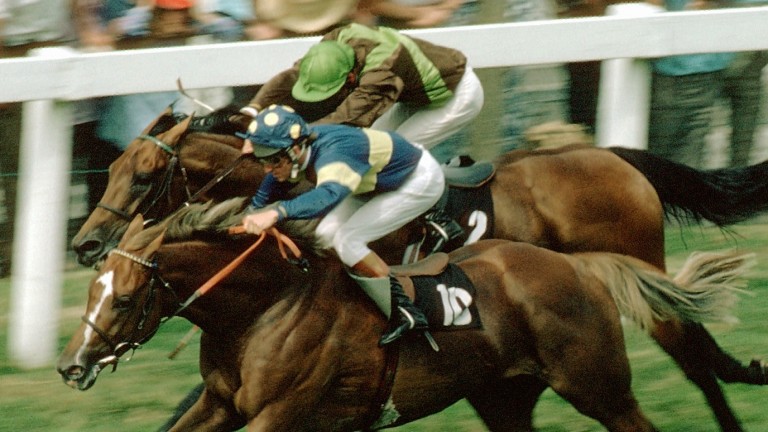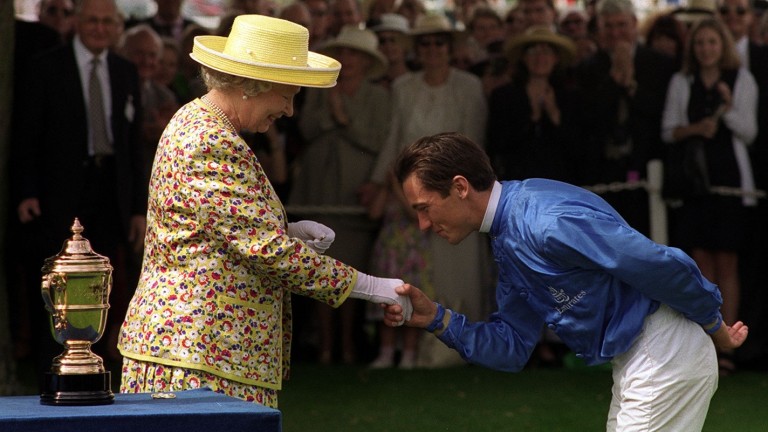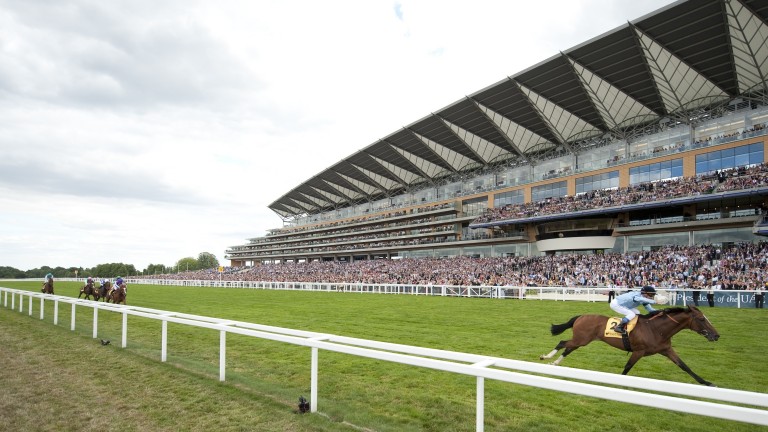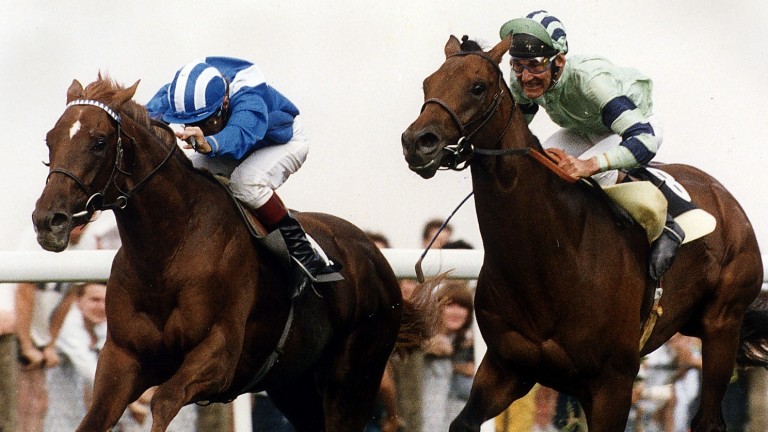Cracksman remains in King George with Kew Gardens an absentee
Cracksman was declared for Ascot’s King George VI and Queen Elizabeth Stakes and Kew Gardens was ruled out by a dirty scope as the complexion of Saturday’s big race changed dramatically on Thursday.
With thunderstorms among the forecast, trainer John Gosden said Cracksman would run provided there was sufficient rainfall after eight horses were declared.
However Aidan O’Brien’s challenge will now comprise of Hydrangea – now the mount of Ryan Moore – and Rostropovich after he admitted some of his horses had been hit by a bug with Queen’s Vase winner Kew Gardens seemingly among those under the weather.
“Kew Gardens didn’t scope 100 per cent clean this morning so we didn’t declare him,” he told the Racing Post.
“We have a few horses not scoping clean and there seems to be a bit of a bug hanging about. Hydrangea seems fine and Ryan rides her.”
King George VI and Queen Elizabeth Stakes card
Cracksman has been a major doubt for the King George due to the quick ground, but the son of Frankel, who won the Prix Ganay and Coronation Cup prior to a defeat by the re-opposing Poet’s Word in the Prince of Wales’s, could now line up and, if he does so, will be ridden by Robert Havlin.
Gosden, who has also declared Coronet, said: ”With thunderstorms forecast it made sense to leave him in the race. If there is sufficient rainfall the intention is to run him.”
Following news of his declaration, bet365 make Cracksman an 11-4 shot for the King George with Poet’s Word their 2-1 favourite.
Owner Anthony Oppenheimer said: ”There is a forecast for Friday which could bring a big amount of rain. He can’t run on good to firm or firm but it seems fair to run him if it does change. We thought we would just see and hope people appreciate that he simply won’t run if there is not proper rain.”
Ascot clerk of the course Chris Stickels confirmed there was a chance of rain falling before Saturday, saying: “There is a risk of some thundery weather, a little tonight but probably more on Friday evening.
“As is the nature with thunderstorms it is completely hit and miss. We could get nothing while there will be a small risk of maybe an inch of rain. Our best guess is somewhere between two and 12 millimetres.
“The ground is good to firm. We finish watering in about an hour and will review the situation again on Friday. We can start watering in the middle of the Friday night if we need to. If thunderstorms are likely it means watering is less likely.”
The field is completed by Crystal Ocean, Poet’s Word, Salouen and Desert Encounter. (fonte : RacingPost)
Midsummer feast attracts a who’s who of Europe’s middle-distance celebrities
Answer three questions for the chance to win a fabulous day at Ascot
Conceived in 1951 to celebrate the Festival of Britain, the King George VI and Queen Elizabeth Stakes was an instant success and swiftly established itself as the premier midsummer destination for the cream of Europe’s middle-distance horses.
That first running attracted such a stellar line-up that it’s hard to believe it was originally envisaged as a one-off and that there was significant opposition to the idea.
Some establishment figures evidently feared a new race offering a record purse to the winning owner of more than £25,000 might upstage the Derby, and also – horror of horrors – that the prize-money might end up in France.
Such fears proved groundless and, 67 years on, the King George and the Derby thrive side by side, a typical gap of seven or eight weeks allowing the Epsom winner to go on to Ascot and very often follow up.
Win a fabulous day for two at Ascot
High Commissioner whisky is offering Racing Post readers the chance to win a luxury hospitality day for two at Ascot on Saturday, September 8, including a private table for the day in the On5 restaurant with four-course a la carte menu and premier admission to the King Edward VII Enclosure. The day’s racing highlight will be the valuable Cunard Stakes.
The On5 restaurant is a fifth-floor glass-fronted restaurant with a trackside viewing balcony and roof-top terrace offering spectacular views of the home straight and Windsor Great Park. The parade ring, pre-parade ring and raceday entertainment are within easy reach via the lift at the restaurant entrance.
The prize includes a drink on arrival, racecard, Racing Post and car parking label.
Simply click here and answer the following three questions correctly.
a) Which filly became the first dual winner of the King George in 1974?
b) In what type of cask is High Commissioner aged?
c) Which colt holds the record for the greatest winning margin in the King George?
All correct entries will be placed in a draw. The first correct set of answers drawn wins the luxury day at Ascot on September 8, with six runners-up each receiving a pair of tickets to the Queen Anne (grandstand) enclosure at Ascot for the same day.
The competition closes at 23.59pm on Saturday, August 4. One entry per person and entrants must be over 18. Full terms and conditions can be viewed here
That inaugural running was the first of many King Georges to attract the Derby winner when Arctic Prince lined up alongside winners of both Guineas and a six-strong French challenge that included the previous year’s Prix de l’Arc de Triomphe victor Tantieme in a field of 19. However, they were all upstaged by Supreme Court, a three-year-old who had been too backward to train as a juvenile but had blossomed in the spring.
Since then the King George has been won by a veritable who’s who of thoroughbred racing. Some of them, like the last Triple Crown winner Nijinsky and the incomparable Shergar are household names even in households with little interest in racing. The rest are instantly recognisable to racing fans the world over.
We have had French winners – plenty of them – and we have even welcomed them. We have had Italian and German winners too, and of course we have also seen plenty of Irish success. We have had the occasional American and Japanese challengers, and last year we even had one from Argentina.
We have had winners of all ages and of both sexes, and we have had two dual winners in the hugely popular French filly Dahlia in 1973 and 1974 and the Godolphin great Swain in 1997 and 1998. We have had flamboyantly impressive winners, dramatic last-stride winners, and hard-as-nails winners who simply refused to accept defeat.
Each in their own way has made for a great spectacle, but none better than the so-called ‘race of the century’ in 1975, when the Derby winner Grundy got the better of an epic final-furlong duel with the older St Leger and Coronation Cup winner Bustino after the latter’s two pacemakers had set such a furious gallop that the course record was obliterated by more than two seconds and even Dahlia, bidding for a hat-trick of King Georges, and Star Appeal, the winner of the Eclipse and Arc that year, were left gasping for breath with two furlongs still to go.
Acceptance of the King George was no doubt hastened by some hugely popular winners in the early days. Tulyar in 1952 was the first of 13 horses to win the Derby and King George in the same year, and Pinza 12 months later was the second.
The King George VI and Queen Elizabeth Stakes – 1951-2017
1951 - A new race, bearing the name of the reigning monarch and his queen, the King George VI and Queen Elizabeth Stakes, is staged as a one-off to mark the Festival of Britain. It is won by Supreme Court
1954 - The Queen wins the race that remembers her parents with Aureole
1956 - The unbeaten, Italian-trained dual Arc winner Ribot wins the King George on his only appearance in Britain
1965 - Lester Piggott lands the first of a record seven King Georges on Meadow Court, part-owned by Bing Crosby
1968 - Trainer Sir Noel Murless lands the King George for the third successive year as Royal Palace follows the victories of Aunt Edith and Busted
1970 - Nijinsky, who went on to win the Triple Crown, maintains his unbeaten record in effortless style
1972 - Brigadier Gerard steps up to a mile and a half for the only time to gain a narrow victory
1974 - A second successive victory for French-trained globetrotting wonder filly Dahlia
1975 - It’s the ‘race of the century’ as Grundy wins a gut-busting battle with Bustino in record time
1981 - The brilliant Shergar wins for the last time. He is defeated in the St Leger and has a short-lived stud career before being kidnapped
1986 - Dancing Brave gains revenge for his Derby defeat by numbering Epsom victor Shahrastani among his victims
1991 - Derby winner Generous strides home seven lengths clear to break Mill Reef’s 1972 record winning margin
1995 - Lammtarra keeps his unbeaten record intact and gives Frankie Dettori the first of five King George victories
1998 - Swain becomes only the second dual winner in the race’s history and one of five Saeed Bin Suroor successes
2001 - Supersire Galileo gives Aidan O’Brien the first of four King George winners
2005 - Azamour delivers trainer John Oxx a second King George, following Alamshar in 2003, in a race run at Newbury while Ascot is redeveloped
2010 - Harbinger, a fifth winner of the race for trainer Sir Michael Stoute, romps home by a record 11 lengths
2013 - Novellist becomes the second successive German-trained winner following Danedream in race record time
2017 - Enable provides John Gosden with a third King George in seven years, following Nathaniel in 2011 and Taghrooda in 2014. Gosden’s father, Towser, won the race with Aggressor in 1960.
Pinza’s success at Epsom was big news because he was Gordon Richards’ first Derby winner at the 28th attempt. If his easy King George success was any less popular it was because he beat the Queen’s runner Aureole, but the royal runner returned in triumph 12 months later to give Ascot one of its most memorable moments, coping bravely with unseasonably heavy ground to see off the French challenger Vamos by three-quarters of a length. The Queen’s delight, winning a race that honoured her father and mother, was just as evident then as it was when Estimate won the Gold Cup nearly 60 years later.
The first truly great winner of the King George arrived in just the race’s sixth running, when the Italian four-year-old Ribot, unbeaten in 13 races including the previous year’s Prix de l’Arc de Triomphe, was lured to Ascot. It was not his best performance by any means – that came back at Longchamp on his final start – but under sticky conditions that did not play to his strengths he still won by five lengths.
Horses of Ribot’s calibre might come along once in a decade if we are lucky, yet at the start of the 1970s three came along in consecutive years.
Nijinsky arrived at Ascot in 1970 unbeaten in nine races and imperious in the 2,000 Guineas, Derby and Irish Derby. Lester Piggott, who remains the King George’s winningmost rider with seven victories, said he had “never been more impressed with a horse” after Nijinsky dismissed the previous year’s Derby winner Blakeney contemptuously.
Geoff Lewis spoke in similar vein 12 months later after the Derby winner Mill Reef won by a then record six lengths – a margin bettered since only by fellow Derby winner Generous when a seven-length winner in 1991 and 19 years later by four-year-old Harbinger, whose freakishly impressive 11-length romp lowered Grundy’s race record.
Mill Reef won as he pleased and Lewis said: “If I had given him a slap the judge would have left his box before the others got there.”
By the time Brigadier Gerard lined up for the King George, Mill Reef had been retired with a fractured foreleg, but he faced strong opposition, lured in part by the opportunity to claim a priceless scalp over a distance that might stretch him, and also by a massive injection of prize-money from the race’s first sponsor, De Beers. He duly took his record to 15 from 15, but it was not one of his defining performances.
Dahlia, Grundy, The Minstrel and Troy all contributed to the claim that the 1970s was the King George’s golden decade, but if the 1980s were in any way inferior it was not by much.
How could they be with winners to marvel at such as Shergar, Dancing Brave, Reference Point, Mtoto and Nashwan?
Shergar won as easily as expected in 1981 following his ten-length Derby success and subsequent effortless Irish Derby victory. Who could have guessed, though, that this would be his last win and that two years later he would be kidnapped by the IRA and never seen again,
Five years later Dancing Brave, who had already left his luckless Derby defeat behind with an impressive win in the Eclipse, had the Epsom winner Shahrastani trailing in fourth when beating Shardari.
The following year Derby winner Reference Point bounced back from Eclipse defeat to make all and win with similar authority to Epsom, giving the brilliant American Steve Cauthen his one and only win in the race, and in 1988 his Eclipse conqueror Mtoto used his trademark turn of foot to devastating effect against the favourite Unfuwain.
Nashwan, an outstanding winner of the Guineas and Derby, brought the curtain down on another great decade without being at his very best against old rival Cacoethes.
Lammtarra was perhaps not a great King George winner on that July day in 1995, but what an extraordinary career he enjoyed. Successful in the Derby on just his second racecourse appearance, he beat the following year’s King George winner Pentire at Ascot on only his third run and signed off in the Arc with a fourth win from four starts.
The Godolphin grey Daylami was dazzling in 1999, John Hammond’s Montjeu was monstrous in ushering in the new millennium 12 months later, and then came Galileo.
Galileo’s prominence in the history of the thoroughbred will no doubt owe much to his record-breaking second career as a stallion and as a sire of sires, but he was a phenomenal racehorse too.
He was already a wide-margin winner of the Derby and Irish Derby when he arrived at Ascot unbeaten in 2001, but he was never seriously tested until the Godolphin five-year-old Fantastic Light ranged upsides a furlong out. Galileo had cruised to the front while Fantastic Light was still looking for room but now he had to battle. Battle he did, his two-length win looking all the better in the light of the runner-up’s subsequent exploits.
It was the first of four King George wins to date for Aidan O’Brien, successful since with Dylan Thomas, Duke Of Marmalade and most recently Highland Reel, one short of the record for the race held jointly by Dick Hern, Sir Michael Stoute and Saeed Bin Suroor.
Nathaniel – following the route taken back in 1978 by Ile De Bourbon in skipping the Derby for Royal Ascot – beat the previous year’s Derby winner Workforce in 2011 and 12 months later went agonisingly close to becoming the third dual winner of the King George when beaten on the nod by the German filly Danedream, the shock winner of the previous year’s Arc.
A son of Galileo, Nathaniel has wasted no time making his mark on King George history for last year’s winner Enable is from his first crop at stud.
Female winners of the King George since Dahlia can be counted on the fingers of one hand, but Enable was the second for Nathaniel’s trainer John Gosden in four years, following Taghrooda, another Oaks winner and an impressive winner in 2014.
Taghrooda was top-class by any measure, but Enable succeeded last year where her predecessor failed, for she also won the Irish Oaks, which Taghrooda missed, and ended a spectacular three-year-old campaign with a fabulous performance in the Arc, a race in which Taghrooda was only third.
Enable will be missing this year while she recovers from injury and there’s no denying the King George will be the poorer for it, but it will take plenty of winning, make no mistake.
For this, as we have seen, is a race in which champions are crowned. The 2018 winner, whoever he or she might be, will be one of the horses of the year. Of this we can be sure.


